Discoveries by revolutionary scientists Augustin-Jean Fresnel, Thomas Young and others have helped shape the modern world of photonics. Technological innovations, ongoing education and training, and the International Year of Light 2015 continue to advance the industry throughout the UK.
Although the name of British physicist Thomas Young is not necessarily widely known, he is far more than a footnote in history. He was a revolutionary of his time, and his work helped shape the photonics industry as we now know it.
Also a physician who studied optical and sense perception, Young established the principle of interference of light in the early 1800s – specifically, that light beams spread apart and overlap when passing through closely set pinholes on a screen. Bands of bright light thus alternate with bands of darkness.
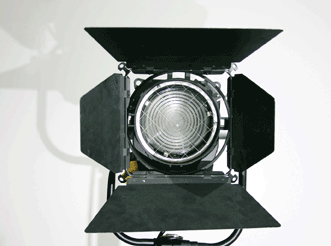
The Fresnel lens, created by Augustin-Jean Fresnel in the early 1800s, was originally developed for use in lighthouses.
This work subsequently established the wave theory of light and polarization; that is, light is a wave, not a stream of corpuscles, or particles, as was previously believed. Young’s theories led to his study of how color is perceived and how thin films relate to wavelengths of light. His findings, along with those of German physicist Hermann L.F. von Helmholtz, prompted the Young-Helmholtz three-color theory.
Augustin-Jean Fresnel, a French physicist who is more commonly known in the industry, had performed studies similar to, yet independent of, Young’s, ultimately reaching the same conclusions relating to the wave theory of light.
Fresnel’s discoveries, theories and equations have had a major influence on light-based and optical innovations in use today – from computers and mobile phones to imaging and optical devices. Most notably, the lens (and many variations of it) that bears Fresnel’s name remains popular for many products such as imaging cameras, solar cells and light sources, as well as for applications in biophotonics and defense and security.
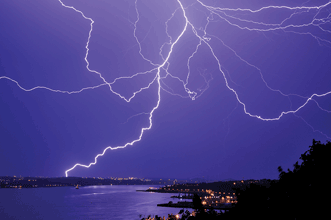
Lightning in Quebec. Courtesy of IYL2015/J.P. Marquis.
But Fresnel’s work goes beyond his lenses, according to Peter Phillipson, chairman of the Society of Light and Lighting’s London Events Committee, which hosted a “200 Years of Fresnel: Why everything we light and look at today depends on what he said” event in March, at the Royal Institution of Great Britain in London, to coincide with the International Year of Light and Light-Based Technologies 2015 (IYL2015).
“Forget his lens for a moment. All of our modern innovations [in photonics] are rooted in Fresnel’s work,” Phillipson said, citing mobile device displays, cameras, lasers and even the fiber optics that power the Internet. “You name it. His theories are the underpinning of light.”
Hundreds of scientists and researchers, and even Britain’s Prince Andrew, Duke of York, attended the program that focused on Fresnel’s wave theory, as well as on how his work continues to impact people’s understanding of light and the many applications it makes possible. Phillipson also conducted experiments using Fresnel’s equations and theories.
Lessons in photonics
The photonics industry has come a long way since the discoveries made by Fresnel and Young, and every sector continues to advance, making education and training necessary. A broad variety of training programs are slated for 2015, many of which fall under the auspices of LIGHT2015, the International Year of Light Europe outreach and education project corresponding with the global IYL2015.
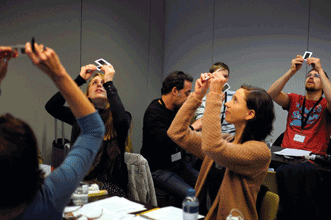
The LIGHT2015 Photonics Explorer Trainers Workshop shows educators effective ways to teach photonics. Courtesy of the European Physical Society.
LIGHT2015 awards for Young Photonics Entrepreneurs and Young Women in Photonics will be presented by the European Optical Society to recognize those making “outstanding technical and/or innovative contributions to the photonics industry.” Organizers say they have the
makings of modern-day revolutionaries – perhaps the Young or Fresnel of their generation.
“The photonics industry needs brave and enthusiastic young talents to think out of the box to search for new business opportunities for their innovations,” said Jyrki Saarinen, executive director of the European Optical Society, which co-sponsors the awards.

Earth lights as seen from the International Space Station. Courtesy of IYL2015/NASA, JSC.
The two awards are meant to highlight the significance of photonics in the overall field of science and in the contributions from women to this diverse industry. The awards will be presented at the World of Photonics Congress in Munich.
Numerous events specifically target innovators, including a series of talks in London, “How to Be Brilliant,” which provide a look at photonics industry opportunities beyond those accessible through formal schooling and training.
A European Unionwide community experiment on smartphone photonics is among the LIGHT2015 scheduled events. During Photonics: Discover the Power of Light, thousands of participants will study optical measurements of the sky to yield information relating to air pollution. It is hoped that this and other such programs will encourage young people to continue advancing light-based technologies well into the future and become groundbreakers like Young and Fresnel.
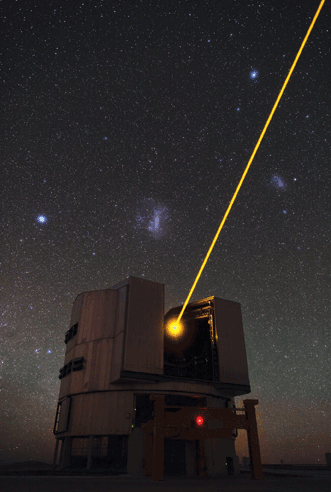
Lasers in the sky. Courtesy of IYL2015/ESO, B. Tafreshi.
The Professional Lighting Summit, an annual event to be held in September in Chester, England, will bring together hundreds of delegates from throughout the UK in an effort to advance education and skills. Attendees can participate in discussions about the latest standards, regulations and challenges facing the photonics industry. In addition, lighting experts will present topical, relevant ideas and information; organizations will exhibit their products and services; and the Institute of Lighting Professionals will offer advice on developing careers in this field.
Another educational initiative aims to put 250 Photonics Explorer kits into the hands of students through the efforts of EYEST, a Belgium-based nonprofit organization that works to attract young people to the fields of engineering, science and technology; the kits are being distributed to teachers across the UK and parts of Europe. According to LIGHT2015 organizers, the training kit is a tool for bringing photonics modules and hands-on experiments into the classroom.
“The Importance of Photonics in Our Everyday Lives,” hosted by the Library of Birmingham in England, features demonstrations, workshops, discussions and exhibitions targeting community groups, children and families. Light Lab at the Leeds City Museum, also in England, provides all ages with hands-on exploration of light in its many forms.
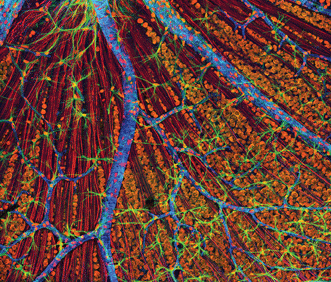
Mouse retina. Courtesy of IYL2015/National Institute of General Medical Sciences.
A yearlong Light: Beyond the Bulb international exhibition program demonstrates, through customized displays, the variety of light-based science and research that exists in all realms of photonics.
SPIE, along with the Chandra X-Ray Center at the Smithsonian Astrophysical Observatory and the International Astronomical Union, is sponsoring the program.
“With its eye-catching images, the Light: Beyond the Bulb program offers an extremely effective means to tell that story,” said SPIE CEO Eugene Arthurs. “We hope the Light: Beyond the Bulb displays will spark inspiration among students looking for careers, inventors looking for technologies that can help transition their ideas into reality.”
Exhibits are featured worldwide, including at Bangor University in Wales, UNESCO in Paris, the Manor Field Primary School in Burgess Hill, England, and the Library of Birmingham.
A film and photo archive at the Petrie Museum of Egyptian Archaeology in London is featured in The Light Project: Capturing Light, while a series of short movies will be showcased through the rest of the year via First Light. This series allows artists to demonstrate their first visual experience. Also at the Petrie Museum was The Light Project: Innovations, which featured University of Cambridge PhD student Meghan Strong discussing her current study of how ancient Egyptians illuminated the world around them.
IYL2015 is allowing the industry to demonstrate the fun side of photonics, too.
The Dancing Light workshop at the Edinburgh International Science Festival, held at the National Museum of Scotland in April, brought photonics to life, quite literally. Participants learned to “move like a photon,” discovering the features of light and its application to everyday technologies via dance and music. Check out our report in the April 22, 2015, edition of Light Matters at photonics.com/lightmatters.
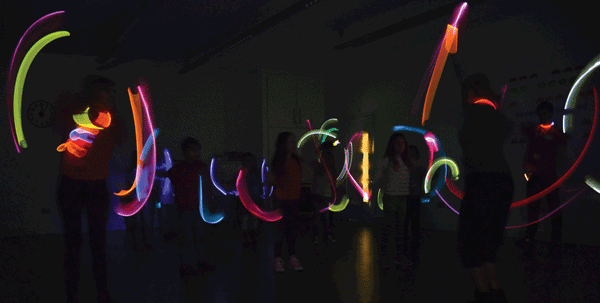
The Dancing Light program taught children about the principles of light by learning to “dance like a photon.” Courtesy of Graeme Sturrock.
Hailed “Britain’s famous light show,” Blackpool Illuminations will commemorate IYL2015 with a run from Sept. 4 to Nov. 8, in addition to a Ride the Lights event on Sept. 1, which invites visitors to explore the attraction’s lights on bicycle. Located in Blackpool, England, the route is 10 km long and uses more than 1 million lights.
Many fun, educational events and programs are rounding out the International Year of Light 2015 in the UK and across Europe. Learn more: www.light2015.org.uk.